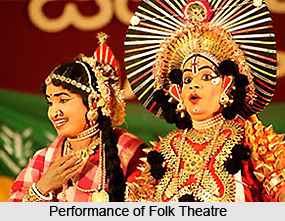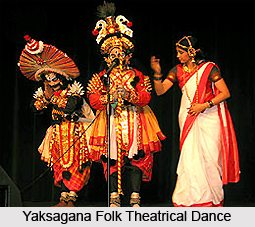 Folk Theatres of South India mirrors the traditions of South India at large. Folk Theatre laid bare the popular culture of India. Folk theatre of Kerala, as generally believed, evolved out of religious ceremonies. However, there are evidences to prove that theatre is indeed older than religion. Very old magical rituals could not have been connected with religion, if not Man had performed `rain dance` and imitation of `animal hunt` as part of his daily ritual. A somewhat similar development, though not having its roots at imitation of animal hunt, can also be detected in the Indian state of Kerala also.
Folk Theatres of South India mirrors the traditions of South India at large. Folk Theatre laid bare the popular culture of India. Folk theatre of Kerala, as generally believed, evolved out of religious ceremonies. However, there are evidences to prove that theatre is indeed older than religion. Very old magical rituals could not have been connected with religion, if not Man had performed `rain dance` and imitation of `animal hunt` as part of his daily ritual. A somewhat similar development, though not having its roots at imitation of animal hunt, can also be detected in the Indian state of Kerala also.
There are some folk dramas like Kurathiyattom, Porattunatakam, Kakkarassinatakam, etc., that are actually not connected with the rituals or even the artistic traditions of Indian state of Kerala. Their plot structures, manner of presentation, linguistic expressions and characters illustrate the influence of Tamil Culture and are popular in those districts that lie close to the state. The Porattunatakam of Trissoor shows features that are strikingly similar of the Porattunatakam of Palakkad that has a heavy Tamil cultural accent. The Kurathiyattom of Kannur has resemblances with the lives of the nomadic kuravas and kurathis of Tamil Nadu. Pankali, a version of Porattunatakam, exists only in Palakkad.
The folk theatre of Kerala, which is of serious importance, is actually ritualistic drama. This hold special features of artistic tradition of Kerala. The content of the plays generally have a compact plot, with proper beginning, middle and end, antithetical characters, logical and orderly development of the plot, four styles of acting, audience participation, environmental acting, improvisation in acting, creation of specific moods, etc., are some of the unique features of the ritualistic theatre of Kerala. The acting is most often realistic.
Tamil Nadu has a rich heritage of dramas as a medium of entertainment. The inhabitants of Tamil Nadu have themselves also developed various dramas of their own. The theatrical plays are supposed to have started from the time of Rajaraja Chola I (985-1014 A.D.). In those days, the dance dramas contained the scenes from the life of Krishna and other legendary stories. Several types of dance-dramas were frequently staged in temples. Almost every temple had a theatre or at least a stage attached to it, which was meant for different forms of entertainment. These dramas are generally performed during religious festivals.
 During the reign of Rajaraja I, the folk drama Rajaraja Natakam was composed. It is believed to be a biographical drama, which highlighted Rajaraja I`s military achievements and the building of the great temple at Tanjavur. The actors were awarded with wet land growing paddy and the best actor was conferred with title. The present day folk drama called Therukkuthu was earlier presented with music, dance and long drawn speeches in Tamil Nadu.
During the reign of Rajaraja I, the folk drama Rajaraja Natakam was composed. It is believed to be a biographical drama, which highlighted Rajaraja I`s military achievements and the building of the great temple at Tanjavur. The actors were awarded with wet land growing paddy and the best actor was conferred with title. The present day folk drama called Therukkuthu was earlier presented with music, dance and long drawn speeches in Tamil Nadu.
Folk theatre of Karnataka highlights the rich tradition and culture of the state in dancing. This form of theatre is also known as "The Village Theatre", "The People`s Theatre" and "The Rural Theatre". The folk theatre mainly marks on the past of a nation`s theatre and also forms the basic structure of amateur and professional theatre of urban areas. Folk theatre acts as a live spring and recurrently supplies all the essential ingredients to other forms of theatre. It preserves, rejuvenates and also inspires cultural achievements of the people. It forms the supplies and source resources for the progress of theatrical art. "Real India lives in her villages", because the village houses the folk with all its "soft green of the soul" of culture, art and tradition. The folk theatre of Karnataka - music, dance and drama, is mainly preserved and protected by the people of villages. Yakshagana and Sannata are some of the prime examples of folk theatre in Karnataka.
Chavittunatakam is a Christian folk drama of Kerala. This dramatic form was initiated during the time of the Portuguese rule in Kerala in the 16th century A.D. The meaning of `Chavittu` is the rhythmic steps which accompany the recitation of lines in the performance. Pagati-veshalu is even another form popular in Andhra Pradesh.
Kuravanji Natakam Kirttanai.




















